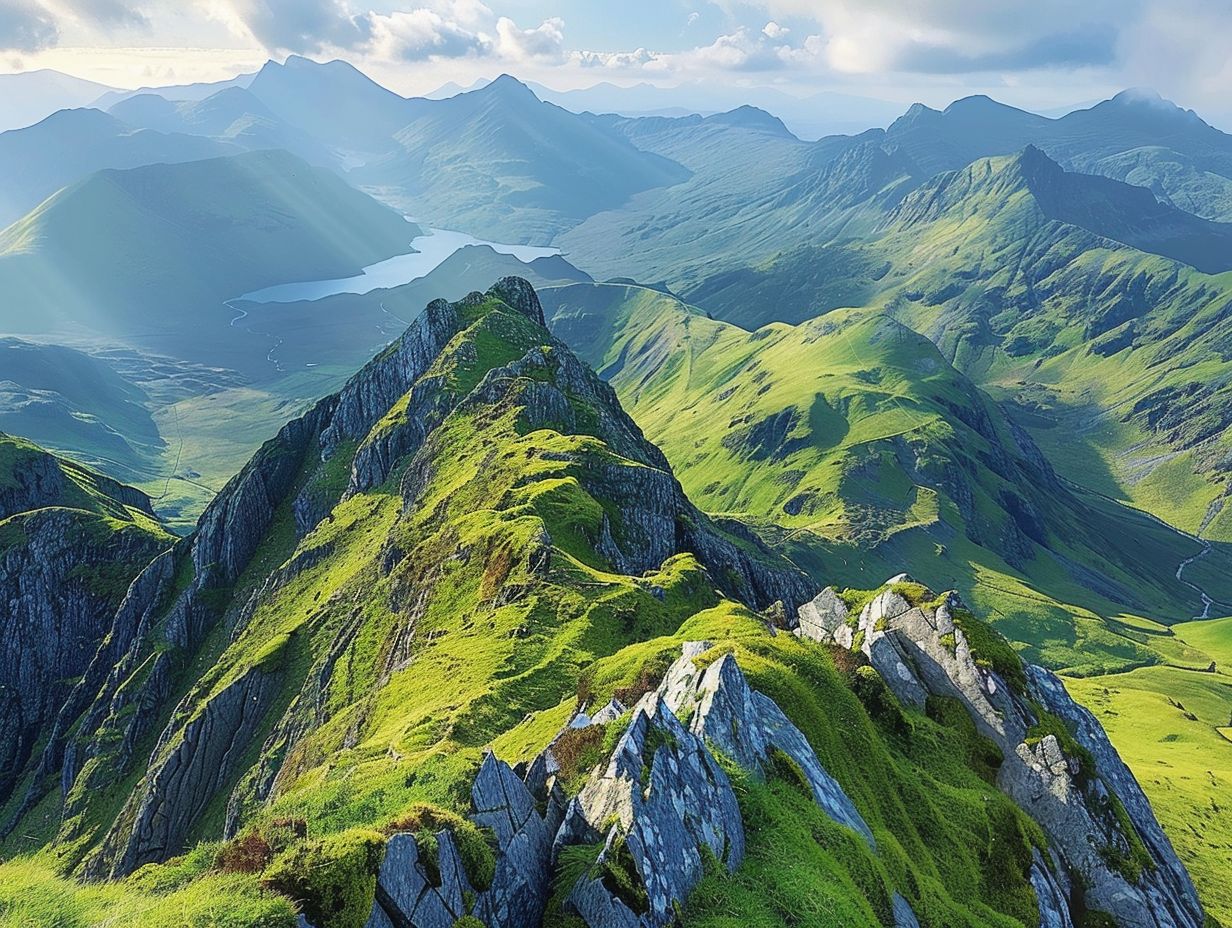Are you ready to begin an unforgettable hiking adventure in the stunning Highlands of Scotland? This detailed guide provides all the information you need before heading out on the trails, including the optimal time to hike and the essential gear and equipment required.
Explore the best hiking routes, understand how to prepare yourself mentally and physically, and learn how to ensure your safety while exploring this awe-inspiring landscape. Whether you are an experienced hiker or a novice, this guide has all the information you need for an unforgettable Highland experience.
Key Takeaways:

- Choose the best time to hike in the Highlands based on weather and personal fitness level.
- Prepare for a safe and enjoyable hike by packing the necessary gear and notifying someone of your plans.
- Stay safe while hiking by being aware of wildlife, knowing how to use a map, and staying hydrated and nourished.
What to Consider Before Hiking in the Highlands
Embarking on a hiking expedition in the Highlands of Scotland presents an exceptional opportunity to immerse oneself in awe-inspiring landscapes. However, it is crucial to take into account several essential factors, including weather conditions, suitable equipment, and physical fitness levels.
These considerations are vital in ensuring a secure and gratifying outdoor experience, whether individuals are obtaining information through the WalkHighlands website or other informational resources.
What is the Best Time to Hike in the Highlands?
The optimum timing for hiking in the Highlands is predominantly influenced by the prevailing weather conditions, which exhibit significant variations across different seasons.
During the summer months, spanning from June to August, are generally regarded as the optimum period for embarking on walking expeditions in the Highlands.
This time frame typically witnesses more stable weather conditions, coupled with longer daylight hours that facilitate the exploration of trails and appreciation of the breathtaking landscapes. It is worth noting, however, that this period tends to attract a higher influx of tourists to the region.
Conversely, both spring and autumn present hikers with milder temperatures and fewer crowds, offering an appealing alternative for those seeking a serene hiking experience.
Winter introduces a distinct ambiance to hiking in the Highlands, characterized by snow-capped mountains and frozen lochs, which contribute to a magical yet demanding setting ideal for seasoned hikers.
What Gear and Equipment Do You Need for Hiking in the Highlands?
Ensuring that one possesses the appropriate gear and equipment, such as durable hiking boots and suitable attire, is imperative for a safe and comfortable hiking experience in the Highlands. Quality hiking boots offering good ankle support are necessary to safeguard one’s feet and ensure stability on uneven terrains.
Additionally, clothing with moisture-wicking properties aids in regulating body temperature and reducing the risk of chafing. It is advisable to pack essential items like a map, compass, and first aid kit, as they can be essential in times of emergencies.
A lightweight and robust backpack proves to be advantageous for carrying supplies effectively. Furthermore, it is essential to remember sun protection essentials like sunglasses, sunscreen, and a hat to shield oneself from the elements while appreciating the picturesque views of the Highlands.
What Are the Physical Requirements for Hiking in the Highlands?
Hiking in the Highlands necessitates a certain level of physical fitness attributable to the diverse terrain and potential challenges inherent in the landscape.
It is imperative to evaluate the complexity level of the trail earmarked for exploration, as distinct routes necessitate varying degrees of physical aptitude. Certain trails may cater more to beginners, whereas others require advanced hiking skills.
Engaging in conditioning exercises before starting a hiking expedition is essential to ensure skill in navigating the rugged paths smoothly. Emphasising exercises that target the musculature of one’s lower body, including but not limited to squats and lunges, facilitates the development of strength and endurance.
Gradually improving one’s cardiovascular fitness through activities such as running or cycling can significantly enhance overall endurance levels, thereby preparing individuals for long treks in the Highlands.
Top Hiking Trails in the Highlands
The Highlands of Scotland are home to some of the most acclaimed hiking trails in the United Kingdom. These trails include renowned routes like Ben Nevis, the West Highland Way, and picturesque paths on the Isle of Skye. Additionally, the area showcases stunning landscapes within Cairngorms National Park and Glencoe Valley.
1. Ben Nevis
Ben Nevis, the highest mountain in the UK, presents an enticing and fulfilling hiking opportunity, drawing adventurers to the Highlands with its remarkable vistas and varied topography. The ascent up Ben Nevis spans approximately 10 miles and typically demands 7-9 hours for completion, contingent upon the individual’s pace and physical condition.
Hikers should anticipate a diverse terrain encompassing rocky trails, steep inclines, and potentially demanding weather conditions, underscoring the necessity of adequate hiking footwear and suitable attire.
During the ascent, the scenery evolves from verdant foliage to rugged rock formations, providing sweeping views of the neighbouring mountains and valleys. Categorised as a strenuous endeavour, this hike mandates a commendable level of physical fitness and endurance to conquer the summit at an elevation of 1,345 metres above sea level.
2. The West Highland Way

The West Highland Way is renowned as one of Scotland’s premier long-distance hiking trails, spanning a distance of 96 miles from Milngavie to Fort William while traversing through some of the most picturesque landscapes in the Highlands.
Noteworthy features of the route involve passages through rugged mountains, tranquil lochs, and historic villages, providing a genuine exposure to Scotland’s natural splendour and rich historical legacy.
Individuals contemplating walking excursions along the West Highland Way are advised to take into account crucial aspects such as lodging alternatives, prevailing weather conditions, and essential items including waterproof attire and durable footwear.
To optimise the expedition, hikers are encouraged to engage with the local culture by indulging in traditional Scottish cuisine, exploring historic sites like Rob Roy’s grave, and capturing awe-inspiring vistas at locations such as Conic Hill.
3. Isle of Skye
The Isle of Skye presents a range of hiking trails, notably the enchanting Fairy Pools and the striking landscape of The Quirain, establishing itself as an essential destination for hikers.
The Fairy Pools are renowned for their crystal-clear blue waters that flow through a sequence of picturesque rock pools, crafting a mystical ambiance reminiscent of a fairy tale.
Exploring the rugged terrain of The Quirain rewards hikers with awe-inspiring sights of towering cliffs, jagged peaks, and expansive panoramas of the Isle of Skye’s remarkable scenery.
These iconic hiking locations provide a distinctive opportunity for individuals to fully immerse themselves in the unrefined beauty and allure of this Scottish island.
4. Cairngorms National Park
The Cairngorms National Park is an expansive region located in the Highlands, renowned for its extensive array of trails that cater to a wide range of hiking abilities, from leisurely forest strolls to demanding mountain ascents.
Visitors to the park have the opportunity to explore various trails, such as the Speyside Way, a long-distance path that provides breathtaking vistas of the River Spey. For those inclined towards more challenging expeditions, the Lairig Ghru route presents a strenuous trek through dramatic mountainous landscapes.
Enthusiasts of natural settings can also partake in the park’s environmental offerings, such as Loch Morlich, an idyllic freshwater lake encircled by sandy beaches that serve as an ideal setting for a peaceful picnic or water-based recreational activities.
In navigating the area, it is imperative to conduct a preliminary assessment of weather conditions, carry essential provisions, and adhere to the Leave No Trace ethical guidelines to ensure the preservation of the park’s aesthetic allure for future generations.
5. Glencoe
Glencoe is widely recognised for its striking landscapes and challenging hiking routes, establishing itself as a favoured destination for individuals in pursuit of both adventure and awe-inspiring vistas amidst the Highlands.
The region is home to numerous prominent trails tailored to diverse hiking skill levels, each presenting a distinct vantage point of the rugged terrain and storied past. One notable example is the West Highland Way, which offers an extensive hike through Scotland’s most picturesque landscapes.
Alternatively, the Hidden Valley trail guides hikers through a narrow ravine enveloped by towering cliffs, while the summit of Buachaille Etive Mor affords sweeping panoramas of the valley below.
Plus its geological significance, Glencoe is rich in historical lore, notably encompassing the infamous Massacre of Glencoe in 1692. Travellers preparing to explore the area are advised to equip themselves with sturdy footwear, an ample supply of water, and attire suitable for the variable weather conditions prevalent in the Highland region.
How to Prepare for a Hike in the Highlands
Preparing for a hike in the Highlands entails careful planning, which includes:
- Choosing the suitable route
- Checking the weather forecast
- Prioritising safety measures
- Ensuring physical readiness for the trails
1. Plan Your Route and Check the Weather
Before commencing any hike in the Highlands, it is imperative to engage in meticulous route planning and consult weather forecasts to ensure a secure and pleasurable trek.
Thorough route planning entails the identification of prominent landmarks, estimation of distances, recognition of potential risks, and establishment of practical timeframes.
Accessing resources such as weather websites, mobile applications, or enlisting the assistance of local ranger stations permits individuals to obtain real-time weather updates that are essential for making well-informed decisions.
If there is abrupt alterations in weather conditions, hikers must be equipped to adjust their plans by carrying additional gear for rain or snow, modifying their route, or contemplating alternate trails. Adaptability is paramount in outdoor excursions, where the capriciousness of nature can present challenges even to the most prepared hikers.
2. Notify Someone of Your Hiking Plans
Informing someone of your hiking plans is an essential safety precaution when exploring the remote regions of the Highlands.
If there is an emergency or unforeseen circumstances that prevent your timely return, having a trusted friend or family member informed of your itinerary can prove to be invaluable. They should be acquainted with specifics such as your departure point, intended route, anticipated time of arrival, and emergency contact information.
By furnishing this comprehensive data, you establish a safety framework in case of any mishaps. Moreover, it facilitates swift location tracking by rescue teams, who benefit from a defined starting point for their search operations. It is imperative to prioritise safety above all else when embarking on wilderness expeditions.
3. Pack the Right Gear and Supplies

It is crucial to ensure the proper packing of gear and supplies, including essential items like food, water, and first aid supplies, to enhance the success of a hike in the Highlands.
Effectively navigating through the rugged terrain and changing weather conditions can be facilitated by carrying a reliable map, compass, and GPS device.
The utilisation of appropriate footwear, such as sturdy hiking boots with reliable ankle support, is imperative for maintaining stability and preventing injuries on uneven trails.
To ensure comfort in varying weather conditions, lightweight and moisture-wicking clothing, including layers for temperature regulation, is essential.
Furthermore, the selection of a rucksack with suitable weight distribution and adjustable straps is important to comfortably carry all necessary supplies throughout the hike.
4. Train and Prepare Physically
It is crucial to undergo physical training and preparation for hiking in the Highlands to effectively handle the diverse and often challenging terrain.
Enhancing endurance and strength through a range of exercises serves to improve stamina and reduce the risk of injuries during the hiking expedition.
Integrating cardiovascular workouts such as running or cycling can enhance cardiovascular fitness, while engaging in strength training routines like squats, lunges, and planks aids in developing the requisite muscles for uphill ascents.
Additionally, focusing on core exercises is essential, as a robust core offers stability and balance on irregular surfaces. A consistent training regimen, coupled with gradual escalation in workout intensity, will enhance readiness for the rigorous demands of hiking in the Highland landscapes.
Staying Safe While Hiking in the Highlands
Ensuring safety during hiking excursions in the Highlands requires a thorough understanding of the native wildlife, skillful navigation of potentially dangerous terrain, and preparedness to deal with emergency situations.
1. Be Aware of Wildlife and Dangerous Terrain
It is imperative to possess knowledge of the local wildlife and terrain when engaging in hiking activities in the Highlands. In this region, hikers may come across various forms of wildlife, including red deer, mountain hares, and golden eagles. It is vital to maintain a respectful distance from these creatures and appreciate them while ensuring personal safety.
The Highland’s rough terrain poses unique challenges, ranging from steep inclines to unpredictable weather patterns. Adhering to designated paths, carrying suitable equipment, and anticipating sudden weather alterations are essential practices. Proper footwear and attire play a critical role in safely navigating these rugged landscapes.
2. Know How to Use a Map and Compass
Proficiency in utilising a map and compass is a fundamental skill set required to navigate the frequently isolated and challenging trails in the Highlands. These tools serve as essential aids for hikers, offering a directional orientation and assisting them in maintaining their intended route, particularly in regions where GPS signals may lack reliability.
A comprehension of interpreting topographic maps and employing a compass to ascertain direction give the power tos hikers to adeptly traverse through unfamiliar terrains. Furthermore, these competencies are instrumental in ensuring that hikers can retrace their steps to safety in scenarios involving unforeseen weather fluctuations or instances of becoming disoriented.
Competency in map and compass navigation establishes an additional layer of safety and self-sufficiency to any outdoor expedition.
3. Stay Hydrated and Nourished
Maintaining adequate hydration and nourishment is imperative when embarking on hikes in the Highlands to sustain energy levels and overall well-being.
It is crucial to carry a reusable water bottle to ensure a sufficient intake of fluids during the hike. High-energy snacks such as trail mix, granola bars, and fruits are not only convenient but also offer a quick energy boost. Additionally, it is advisable to include nutrient-rich foods like nuts, seeds, and protein bars in your provisions to provide sustained stamina during extended treks.
It is important to schedule regular breaks to replenish fluids and nourishment, as dehydration and low energy levels can result in fatigue and diminished performance on the trail.
4. Be Prepared for Emergencies
Being prepared for emergencies is a crucial component of hiking safety, especially in the remote and unpredictable environments found in the Highlands.
It is imperative to carry a well-equipped first aid kit when venturing into the wilderness. The kit should contain essential items such as bandages, antiseptic wipes, painkillers, and any necessary personal medications.
It is also important to familiarize oneself with the rescue procedures specific to the area being explored, including techniques for signalling for help and navigating back to safety.
Additionally, it is recommended to have a list of emergency contacts stored in your phone and written on waterproof paper to mitigate any connectivity issues that may arise. Before embarking on any hiking adventure, it is crucial to communicate your plans with a reliable individual for added safety measures.
Frequently Asked Questions

What is ‘Exploring the Highlands: A Comprehensive Hiking Guide’?
‘Exploring the Highlands: A Comprehensive Hiking Guide’ is a book that serves as a detailed and informative guide for hikers who want to explore the beautiful and rugged terrain of the Scottish Highlands. It provides essential information such as trail maps, difficulty levels, and must-see destinations, making it the perfect companion for any hiking enthusiast.
Is this book suitable for all levels of hikers?
Yes, ‘Exploring the Highlands: A Comprehensive Hiking Guide’ caters to hikers of all levels. Whether you’re a beginner looking for easier trails or an experienced hiker seeking challenging routes, this guide has something for everyone.
What kind of information can I expect to find in this guide?
This guide covers a wide range of topics, including detailed trail descriptions, difficulty levels, estimated hiking times, trail maps, and essential safety tips. It also provides information on local wildlife, history, and cultural landmarks that can be found along the hiking trails.
Can I use this guide as my sole resource for planning a hiking trip to the Scottish Highlands?
While ‘Exploring the Highlands: A Comprehensive Hiking Guide’ is a valuable resource, we recommend using it in combination with other resources such as online forums, local guides, and official park websites to ensure a well-rounded and thorough plan for your hiking trip.
Is this guide updated regularly?
Yes, ‘Exploring the Highlands: A Comprehensive Hiking Guide’ is regularly updated to ensure the accuracy and relevance of information. We strive to include the latest trail conditions, closures, and any other important updates to ensure a safe and enjoyable hiking experience for our readers.
Where can I purchase ‘Exploring the Highlands: A Comprehensive Hiking Guide’?
You can purchase ‘Exploring the Highlands: A Comprehensive Hiking Guide’ online through various retailers or at select bookstores in Scotland. It is available in both print and digital formats for your convenience.

